"I Promise to pay the Bearer
on Demand FIVE POUNDS, here or at
Messrs Smith Payne & Smiths Bankers LONDON.
Value rec'd WIRKSWORTH 24 August 1829
No. 3420
(E & P Hill & Peat?) For Richd Arkwright & Compy
Chas Arkwright"
Price at Auction £3,335
(believed to be a world record price)
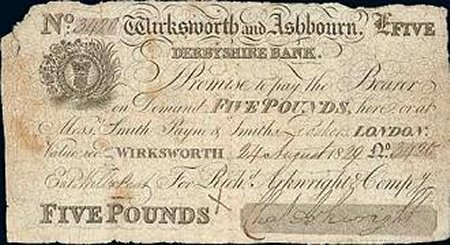
Wirksworth & Ashbourne, Derbyshire Bank, £5, Wirksworth,
21 Dec 1840, serial number N916, black and white, arms top centre,
value low left and top right, for Arkwright & Company.
(cf Grant 3246C), probably a contemporary forgery, fine, rare.
Estimate £200-250.
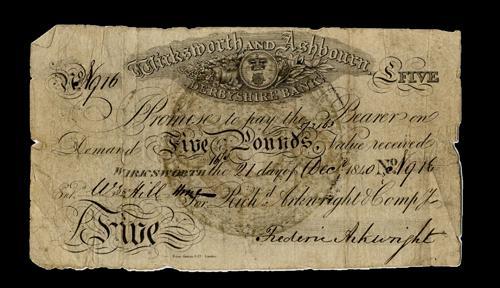
Wirksworth & Ashbourne, Derbyshire Bank, £10, 4 April 1842,
serial number 3223, black and white, arms within wreath top left,
value low left and top right, for Richard Arkwright & Company,
signed Frederick Arkwright and with blue overprint at left.
(Grant 3246C), red with cancellation of signature, split and rejoined,
very good, rare.
Estimate £300-400
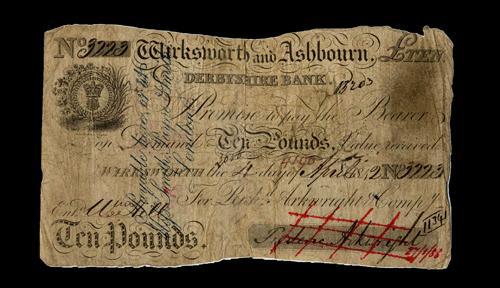
Wirksworth paper money 1840-1843
Wirksworth and Ashbourn Bank,
forerunner of the present Lloyds Bank
in Wirksworth, was founded by John Toplis in 1780.
Richard Arkwright
Junior became a partner in 1804, taking over full ownership in 1829
with his sons Peter and Charles, each holding a third share in the
capital. The bank was known locally as Richard Arkwright and Co.
At that time merchants and businessmen would start up their own banks
and issue their own banknotes, which were like a form of IOU.
An idea of the value of such notes is given on
Wages and Money. Here is the average annual
earnings of some occupations in 1851.
Agricultural Labourer £29
Policeman 54
Miner 55
Teacher 81
Surgeon 200
Clergyman 267
Recently, the purchase of such a banknote hit the headlines.
Rare Arkwright Five Pound Note Sold. 30 April 2004
A Five pound note issued by the old Wirksworth and Ashbourn Bank has
been sold by auctioneers Spink in London for £3,335. The note, serial
number 3420, was issued on 24 August 1829 and is signed by Charles
Arkwright, a son of Richard Arkwright Junior.
The note was bought by Robert Aram, the owner of Masson Mills, who paid
a world record price for such a note at the time. A copy
is displayed in the Working Textile Museum at Masson.
A photo of the note is shown top left.
Robert Aram is reported as saying:
"I did not start to bid until near the end of the auction, as there were
a few other potential buyers at the beginning, but as the
bidding went higher only I and a millionaire collector from Jersey were
left in.
Eventually I bought it for over £3,400 and I feel that it was
worth every penny to save this very important piece of Derbyshire's
local history from disappearing from the area, possibly for ever.
I would have paid more, as the chance of acquiring something like this
might only come up once in a lifetime."
Wirksworth & Ashbourne Derbyshire Bank, £10, 27 March 1843,
serial number 3406, black and white, arms within wreath top left,
value low left and top right, for Richard Arkwright & Company,
signed Frederick Arkwright and with blue overprint at left.
(Grant 3246C), fine with interesting attached note, rare.
Estimate £450-550
Note reads:"Genuine £10 Note of Messers Richard Arkwright & Co
dated 27 March 1843. paid 14 Augst 1889 - 46 years in circulation
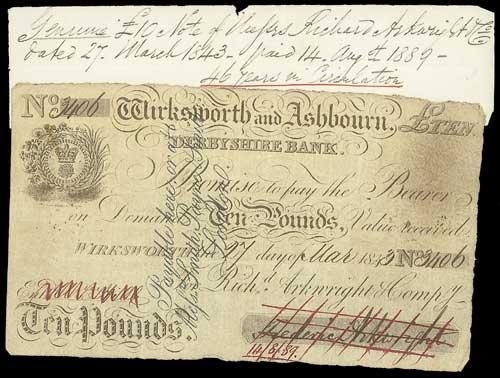
-
Wirksworth and Ashbourn Bank,
forerunner of the present Lloyds Bank
in Wirksworth, was founded by John Toplis in 1780.
Richard Arkwright
Junior became a partner in 1804, taking over full ownership in 1829
with his sons Peter and Charles, each holding a third share in the
capital. The bank was known locally as Richard Arkwright and Co.
At that time merchants and businessmen would start up their own banks and issue their own banknotes, which were like a form of IOU.
An idea of the value of such notes is given on
Wages and Money. Here is the average annual
earnings of some occupations in 1851.
Agricultural Labourer £29
Policeman 54
Miner 55
Teacher 81
Surgeon 200
Clergyman 267
Recently, the purchase of such a banknote hit the headlines.
Rare Arkwright Five Pound Note Sold. 30 April 2004 |
The note was bought by Robert Aram, the owner of Masson Mills, who paid a world record price for such a note at the time. A copy is displayed in the Working Textile Museum at Masson. A photo of the note is shown top left.
Robert Aram is reported as saying:
"I did not start to bid until near the end of the auction, as there were
a few other potential buyers at the beginning, but as the
bidding went higher only I and a millionaire collector from Jersey were
left in.
Eventually I bought it for over £3,400 and I feel that it was worth every penny to save this very important piece of Derbyshire's local history from disappearing from the area, possibly for ever. I would have paid more, as the chance of acquiring something like this might only come up once in a lifetime."
Estimate £450-550
Note reads:"Genuine £10 Note of Messers Richard Arkwright & Co dated 27 March 1843. paid 14 Augst 1889 - 46 years in circulation

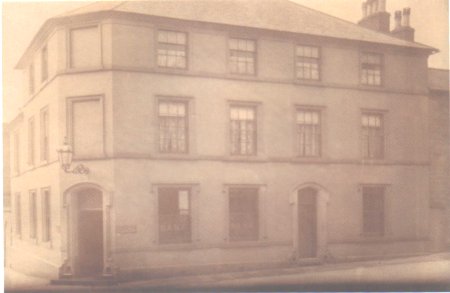
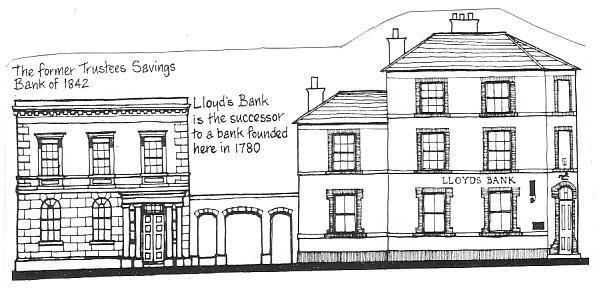
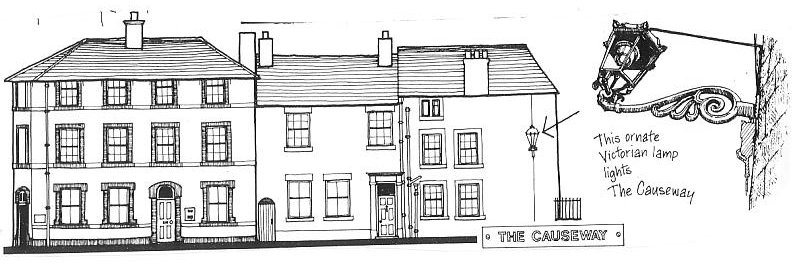
 All Rights Reserved.
All Rights Reserved.